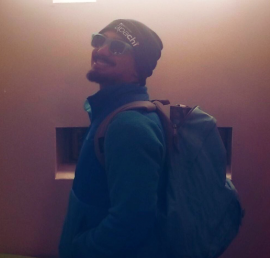The ‘3 Rs’ of online learning: reading, reaching out and respect

When assistant professor Zachary McDowell’s classes begin this fall, he will be ready to use the lessons he learned this spring after the classes he taught were moved online because of COVID-19.
McDowell, a faculty member in the communication department in the College of Liberal Arts and Sciences, will be teaching the same classes he taught in the spring: Communication Technology to about 100 students, as well as Public Relations and Digital Media, a workshop class to about 23 students.
What he quickly learned in the spring was that even though one of his classes was designed to be an online course, he knew he had to modify it to meet the needs of the students in their new realities.
McDowell recognized that when students took up residence in their family home, shared living quarters or wherever they went to study and work, they were going to have a different learning experience. He had to listen to his students about their experiences and create an environment that fostered remote learning.
“What was happening was that for a lot of students, they just couldn’t concentrate long term because they had brothers or sisters around or the family had a single laptop that three people were sharing,” McDowell said. “Trying to understand that and give space to the students to be able to react to their environment was really important.”
In each of his classes, he worked to give his students “space” that would allow them the flexibility to participate.
The larger class, which he ran with several teaching assistants, was designed in accordance with instructional design standards and follows the “University Without Walls” initiatives that cater to adult learners online. It was designed to be asynchronous with video lectures, which allowed students to check in on their own schedules. This larger class also was broken up into smaller sections that lent themselves to small, workshop-like sessions where students would have discussion prompts that would lead to interaction with each other, as well as himself and the other instructors.
He also modified the assignments at the end of the class to be more of a reflective assignment that allowed them to think about how they used technology during the pandemic. Students wrote about how important video-chatting was with other students and how reliant they were on their smartphones to be able to interact in smaller settings.
His smaller class, which was designed as a traditional in-class setting, also was broken up into groups of three or four students that he would lead in workshops to work on writing assignments.
“It really worked well because the students who might have been embarrassed to talk to the whole group about their project difficulties were much more readily able to discuss all of the different things going on in their lives, not only in my class but in others,” McDowell said. “I think the online learning transition was the least of their concern; it was more about the ability for students to make space for learning.”
He is currently refining his classes for fall but will maintain much of what he used in the spring. In the smaller class, he plans to use a combination of asynchronous and synchronous learning. His larger class will be completely asynchronous with pre-recorded video lectures and discussion prompts, but he will be available for questions and breakout discussion sessions.
With the smaller classes, where some level of synchronous learning must be maintained, students will read and be involved with online discussion and writing workshops separately but will have the ability to meet in a full class session.
From what he learned in the spring, he said among the key suggestions he offers is to communicate constantly with students and provide clear instructions that are repeated, “multiple times, multiple ways.” These include sending updates as announcements as well as emails on at least a weekly basis and setting up a “digital hallway” forum for students to ask questions and update instructions.
He also suggested grading in a transparent way with detailed rubrics that are shared with students to use as a guideline on “how to get the grade you want,” he said.
Chronological organization is key, he said. He suggests organizing material into weeks and laying out the online course as though it were a syllabus with all readings, discussions and assignments linked directly to the week’s section.
“The less clicks for them to navigate, the better,” McDowell said.
He said to reframe assignments as course goals and learning goals and consider what needs to be accomplished pedagogically. McDowell stressed that the most important thing a teacher can provide is understanding.
“Be patient and kind,” McDowell said. “Students are going through a lot more than you think. Give them space to learn and grow and fail. They need encouragement, as the rest of the world is frustrating and confusing.”

One of his students during spring was Emilio Davis, a communication major who will be entering his senior year this fall.
Davis said that while the transition in the spring was quick, he understands that it had to be out of necessity. But he thought McDowell was able to seamlessly make the transition.
“What he made very clear was that our health and safety was the priority,” Davis said. “We would meet once a week or so on Zoom and spend the first 20 minutes talking about how the quarantine had affected us, how we were feeling, how we were passing the time, etc. He made sure to always remind us that he was there if we needed anything, be it advice, resources or just a conversation.”
He said the professor streamlined assignments to help ease the load and had a “lead from the front” mentality that helped the class complete their assignments and projects.
“I can’t speak highly enough of Dr. McDowell. He’s one of the few educators I’ve met in my academic career that makes students feel as though they’re working towards a common goal with the teacher, rather than just completing work to satisfy a requirement for a grade,” said Davis.
